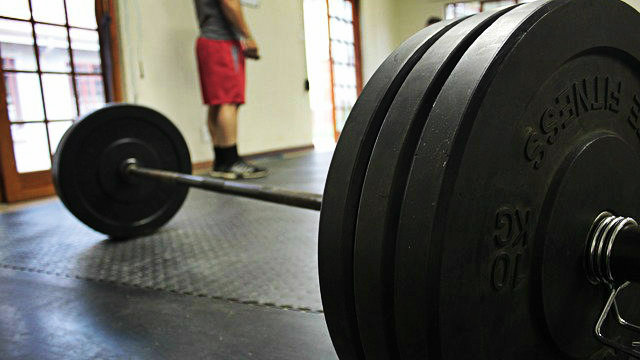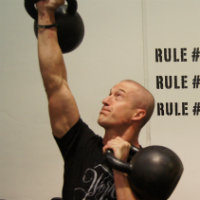 Reading Time: 5 minutes
Reading Time: 5 minutesOne of the hardest parts about getting older is accepting that maybe things just don’t work like they used to. As the lyrics go, “I may not be as great as I once was, but I’m as great once as I ever was.” I know I can still lay the smack down in the gym if I want to and shame my younger clients – but they’ll be able to do it again tomorrow and I’ll need a few days off to deal with the consequences.
Looking at the research, it’s easy to feel like you need to wrap yourself in cotton wool if you’re over 40. What is commonly thought of as gospel in fitness is that there is automatically a decline in strength, VO2 max, and flexibility as we age (and I’ve been guilty of this thinking, too).
Recently, I’ve been wondering if this has to be true. Not too long ago, doctors actually advised anyone over 40 to take it easy, fearing their bodies would no longer be able to handle the stress of exercise or competition. Athletically, anyone “masters” age was put out to pasture.
But these days, we have age-group competitions for everything from Brazilian jiu jitsu to Ironman to weightlifting. These competitive outlets for older athletes are showing the decline isn’t as bad as the research says – and it’s important to realize the research was done on people who were being encouraged to take it easy.
At this point I need to make a disclaimer: Whenever I write on this topic, I am met with comments like, “I’m in the best shape of my life at 45,” which is fantastic but what it really says is that you weren’t in very good shape at twenty or thirty. Biology still exists, hormone levels still drop, and performance still decreases. What I am saying is that there are ways to minimize it.
The Critical Training Principle of Athletes Over 40
One of the least used, yet most important training principles is that of volume. Back when I first started training people, we always looked to add volume before intensity/effort. These days, the opposite is true – everyone thinks they need to add load first and foremost.
The problem with adding load first is that sooner or later it burns you out. Let’s use an RPE (rate of perceived exertion) scale as an example. The world of training is filled with hints as to what our average intensity should be if we plan on training continuously. These truths are evident in both endurance and strength training despite their seeming differences.
For endurance work, the majority of the year (80%) should be spent on efforts at 70% of your max heart rate or below, with only 20% of your time spent above that threshold. For strength, the Russians learned long ago that 72% (+/- 2%) is the magic number. So what we see is that for consistent year-round training, we need to keep the relative intensity at around the 70% mark for most of our training. We also see that we should turn it up and go hard for one in every five workouts.
When you first come into the gym, you won’t be capable of working too hard. Your early lifts will be only around 50-60% of your capabilities. In other words, you’ll be working at 60% of your max. If we use a theoretical 100kg maximum lift as your target, and you begin at 60kg (60%), that training session will be fine and you’ll recover easily.
However, most training plans tell you to add 5kg per week or session. So session two is 65kg, session 70kg, and session four is 75kg. At this point we’re starting to get into the danger zone and suddenly we’re working at 80%, 85%, 90%, and beyond session after session. Do you know what happens if you only try to add load (and in this case load and intensity are the same thing)? Injury or burnout.
A far smarter way to progress is to add volume at that 70% mark. If today you did three sets of three at 70kg, then for the next workout just add some reps. Here’s what the progression might look like:
- Session 1: 3 x 3 at 70kg
- Session 2: 4 x 3 at 70kg
- Session 3: 5 x 3 at 70kg
- Session 4: 5 x 4 at 70kg
- Session 5: 5 x 5 at 70kg
In the same five workouts, you’ve merely added more relatively easy work at 70% instead of going all out for the session.
The Real Magic of This Approach
A workout done at 90+% of your best is a tough workout. It may take you a few days to recover before you can push hard again. A workout done at 70% requires next to no recovery. In most cases, you could even get back in the gym and do the exact same workout tomorrow.
In a given week, by working slightly easier but with more volume, you could easily hit 75 reps on a given exercise (5 sets of 5 reps x 3 workouts). Using our 70% example above, that would give you a total tonnage of 5,250kg for the week. In contrast, if you chose to work up to 90kg, then you’d be lucky to hit five sets of five for a single workout. But even if you did, you’d only hit 2,250kg in that session and it would likely leave you too sore and fatigued to repeat that workout for a few days. If you did manage to somehow repeat that workout, you’d still only accumulate 4,500kg for the week.
Imagine you’re training for competition:
- Using the volume approach – Multiple 70% workouts will have allowed you to hit 5,250kg each week, so at the end of a month you’d have moved 21,000kg total.
- Using the increased load/intensity approach – Even if you managed to perform the 90% workout twice per week for the whole month, which is highly unlikely, you’d only have lifted 18,000kg total.
When it comes competition time, which athlete would you rather be? The one who has put more money in the bank in terms of strength development or the one who had a “go hard or go home” mentality? Consistency will trump intensity every time.
This approach is what has allowed me to complete things like SEALFIT’s Kokoro camp and keep up with kids on their way to BUD/S or to hold my own wrestling against people two-thirds my age in BJJ class. If you focus on adding volume at a moderate intensity, then you’ll find recovery easier and you can train more. That’s exactly the sort of thing that will help you prove that you can still be competitive at 40-plus.







